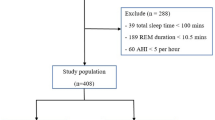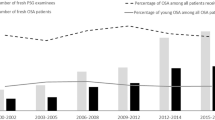Abstract
Objectives:
In contrast to obstructive sleep apnea (OSA), central sleep apnea (CSA) in obese children has received lesser attention. As pediatric CSA is more prevalent than expected and adversely impacts health, this study aims to elucidate the major factors associated with central apnea index (CAI) and compare CSA between obese and non-obese children.
Methods:
Retrospective analysis was performed in a tertiary referral medical center. Children with sleep-disordered breathing (SDB) ranging from 2–18 years old were enrolled. All participants completed history taking, otolaryngological examination and overnight polysomnography. CSA was defined as having CAI exceeding 1 h−1. CAI and the prevalence of CSA were analyzed in children of different age groups, weight statuses and adenotonsillar sizes.
Results:
A total of 487 cases were included. The prevalence of CSA was 13.3% (65/487). CAI was negatively correlated with age (r=−0.32, P<0.001). Obese children had a significantly lower CAI than that of non-obese ones (0.20±0.36 vs 0.48±0.82 h−1, P<0.001). Multiple linear regression analysis demonstrated a relationship between CAI, age and obesity as ‘CAI=0.883–0.055 × Age –0.22 × (Obesity)’.
Conclusions:
In children with SDB, younger ones have a significantly higher CAI than older ones. Additionally, obese children had a lower CAI than non-obese ones.
This is a preview of subscription content, access via your institution
Access options
Subscribe to this journal
Receive 12 print issues and online access
$259.00 per year
only $21.58 per issue
Buy this article
- Purchase on Springer Link
- Instant access to full article PDF
Prices may be subject to local taxes which are calculated during checkout

Similar content being viewed by others
References
O'Brien LM, Holbrook CR, Mervis CB, Klaus CJ, Bruner JL, Raffield TJ et al. Sleep and neurobehavioral characteristics of 5- to 7-year-old children with parentally reported symptoms of attention-deficit/hyperactivity disorder. Pediatrics 2003; 111: 554–563.
Brunetti L, Rana S, Lospalluti ML, Pietrafesa A, Francavilla R, Fanelli M et al. Prevalence of obstructive sleep apnea syndrome in a cohort of 1,207 children of southern Italy. Chest 2001; 120: 1930–1935.
Lumeng JC, Chervin RD . Epidemiology of pediatric obstructive sleep apnea. Proc Am Thorac Soc 2008; 5: 242–252.
Naughton MT, Benard DC, Liu PP, Rutherford R, Rankin F, Bradley TD . Effects of nasal CPAP on sympathetic activity in patients with heart failure and central sleep apnea. Am J Resp Crit Care Med 1995; 152: 473–479.
Spaak J, Egri ZJ, Kubo T, Yu E, Ando S, Kaneko Y et al. Muscle sympathetic nerve activity during wakefulness in heart failure patients with and without sleep apnea. Hypertension 2005; 46: 1327–1332.
Kasai T . Sleep apnea and heart failure. J Cardiol 2012; 60: 78–85.
Leung RS, Diep TM, Bowman ME, Lorenzi-Filho G, Bradley TD . Provocation of ventricular ectopy by cheyne-stokes respiration in patients with heart failure. Sleep 2004; 27: 1337–1343.
Johansson P, Alehagen U, Svanborg E, Dahlstrom U, Brostrom A . Sleep disordered breathing in an elderly community-living population: relationship to cardiac function, insomnia symptoms and daytime sleepiness. Sleep Med 2009; 10: 1005–1011.
O'Driscoll DM, Foster AM, Ng ML, Yang JS, Bashir F, Wong S et al. Central apnoeas have significant effects on blood pressure and heart rate in children. J Sleep Res 2009; 18: 415–421.
Baldassari CM, Kepchar J, Bryant L, Beydoun H, Choi S . Changes in central apnea index following pediatric adenotonsillectomy. Otolaryngol Head Neck Surg 2012; 146: 487–490.
Cole TJ, Bellizzi MC, Flegal KM, Dietz WH . Establishing a standard definition for child overweight and obesity worldwide: international survey. BMJ 2000; 320: 1240–1243.
Huang YC . Body mass index reference for Taiwanese children and adolescents. J Med Sci 2002; 22: 221–226.
Fujioka M, Young LW, Girdany BR . Radiographic evaluation of adenoidal size in children: adenoidal-nasopharyngeal ratio. Am J Roentgenol 1979; 133: 401–404.
Major MP, Flores-Mir C, Major PW . Assessment of lateral cephalometric diagnosis of adenoid hypertrophy and posterior upper airway obstruction: a systematic review. Am J Orthodont Dentofacial Orthoped 2006; 130: 700–708.
Xu Z, Jiaqing A, Yuchuan L, Shen K . A case-control study of obstructive sleep apnea-hypopnea syndrome in obese and non-obese Chinese children. Chest 2008; 133: 684–689.
Brodsky L, Moore L, Stanievich JF . A comparison of tonsillar size and oropharyngeal dimensions in children with obstructive adenotonsillar hypertrophy. Int J Pediatr Otorhinolaryngol 1987; 13: 149–156.
Hsu WC, Kang KT, Weng WC, Lee PL . Impacts of body weight after surgery for obstructive sleep apnea in children. Int J Obes (Lond) 2013; 37: 527–531.
Kang KT, Weng WC, Yeh TH, Lee PL, Hsu WC . Validation of the Chinese version OSA-18 qualityoflife questionnaire in Taiwanese children with obstructive sleep apnea. J Formos Med Assoc 2012, http://dx.doi.org/10.1016/j.jfma.2012.10.002.
Accardo JA, Shults J, Leonard MB, Traylor J, Marcus CL . Differences in overnight polysomnography scores using the adult and pediatric criteria for respiratory events in adolescents. Sleep 2010; 33: 1333–1339.
Iber C, Ancoli-Israel S, Chesson A, Quan S . The AASM manual for the scoring of sleep and associated events: rules, terminology and technical specifications. American Acadamy of Sleep Medicine: Westchester, IL, USA, 2007. pp 45–50.
Carskadon MA, Harvey K, Dement WC, Guilleminault C, Simmons FB, Anders TF . Respiration during sleep in children. Western J Med 1978; 128: 477–481.
Verhulst SL, Schrauwen N, Haentjens D, Van Gaal L, De Backer WA, Desager KN . Reference values for sleep-related respiratory variables in asymptomatic European children and adolescents. Pediatr Pulmonol 2007; 42: 159–167.
Witmans MB, Keens TG, Davidson Ward SL, Marcus CL . Obstructive hypopneas in children and adolescents: normal values. Am J Respir Crit Care Med 2003; 168: 1540.
Marcus CL, Omlin KJ, Basinki DJ, Bailey SL, Rachal AB, Von Pechmann WS et al. Normal polysomnographic values for children and adolescents. Am Rev Respir Dis 1992; 146: 1235–1239.
Uliel S, Tauman R, Greenfeld M, Sivan Y . Normal polysomnographic respiratory values in children and adolescents. Chest 2004; 125: 872–878.
Phillipson EA . Control of breathing during sleep. Am Rev Respir Dis 1978; 118: 909–939.
Eckert DJ, Jordan AS, Merchia P, Malhotra A . Central sleep apnea: pathophysiology and treatment. Chest 2007; 131: 595–607.
Traeger N, Schultz B, Pollock AN, Mason T, Marcus CL, Arens R . Polysomnographic values in children 2–9 years old: additional data and review of the literature. Pediatr Pulmonol 2005; 40: 22–30.
Kritzinger FE, Al-Saleh S, Narang I . Descriptive analysis of central sleep apnea in childhood at a single center. Pediatr Pulmonol 2011; 46: 1023–1030.
Dempsey JA . Crossing the apnoeic threshold: causes and consequences. Exp Physiol 2005; 90: 13–24.
Horner RL, Sanford LD, Pack AI, Morrison AR . Activation of a distinct arousal state immediately after spontaneous awakening from sleep. Brain Res 1997; 778: 127–134.
American Thoracic Society. Standards and indications for cardiopulmonary sleep studies in children. Am J Respir Crit Care Med 1996; 153: 866–878.
Don DM, Geller KA, Koempel JA, Ward SD . Age specific differences in pediatric obstructive sleep apnea. Int J Pediatr Otorhinolaryngol 2009; 73: 1025–1028.
Montgomery-Downs HE, O'Brien LM, Gulliver TE, Gozal D . Polysomnographic characteristics in normal preschool and early school-aged children. Pediatrics 2006; 117: 741–753.
Driessen C, Mathijssen IM, De Groot MR, Joosten KF . Does central sleep apnea occur in children with syndromic craniosynostosis? Respir Physiol Neurobiol 2012; 181: 321–325.
Steier J, Jolley CJ, Seymour J, Roughton M, Polkey MI, Moxham J . Neural respiratory drive in obesity. Thorax 2009; 64: 719–725.
Considine RV, Sinha MK, Heiman ML, Kriauciunas A, Stephens TW, Nyce MR et al. Serum immunoreactive-leptin concentrations in normal-weight and obese humans. New Engl J Med 1996; 334: 292–295.
Nishimura R, Sano H, Matsudaira T, Miyashita Y, Morimoto A, Shirasawa T et al. Childhood obesity and its relation to serum adiponectin and leptin: a report from a population-based study. Diab Res Clin Pract 2007; 76: 245–250.
Schoppen S, Riestra P, Garcia-Anguita A, Lopez-Simon L, Cano B, de Oya I et al. Leptin and adiponectin levels in pubertal children: relationship with anthropometric variables and body composition. Clin Chem Lab Med 2010; 48: 707–711.
Antunes H, Santos C, Carvalho S . Serum leptin levels in overweight children and adolescents. Br J Nutr 2009; 101: 1262–1266.
Nishimura R, Sano H, Matsudaira T, Morimoto A, Miyashita Y, Shirasawa T et al. Changes in body mass index, leptin and adiponectin in Japanese children during a three-year follow-up period: a population-based cohort study. Cardiovasc Diabetol 2009; 8: 30.
O'Donnell CP, Schaub CD, Haines AS, Berkowitz DE, Tankersley CG, Schwartz AR et al. Leptin prevents respiratory depression in obesity. Am J Respir Crit Care Med 1999; 159: 1477–1484.
Phipps PR, Starritt E, Caterson I, Grunstein RR . Association of serum leptin with hypoventilation in human obesity. Thorax 2002; 57: 75–76.
Shimura R, Tatsumi K, Nakamura A, Kasahara Y, Tanabe N, Takiguchi Y et al. Fat accumulation, leptin, and hypercapnia in obstructive sleep apnea-hypopnea syndrome. Chest 2005; 127: 543–549.
Mokhlesi B, Tulaimat A, Faibussowitsch I, Wang Y, Evans AT . Obesity hypoventilation syndrome: prevalence and predictors in patients with obstructive sleep apnea. Sleep Breath 2007; 11: 117–124.
Trakada GP, Steiropoulos P, Nena E, Constandinidis TC, Bouros D . Prevalence and clinical characteristics of obesity hypoventilation syndrome among individuals reporting sleep-related breathing symptoms in northern Greece. Sleep Breath 2010; 14: 381–386.
Verin E, Tardif C, Pasquis P . Prevalence of daytime hypercapnia or hypoxia in patients with OSAS and normal lung function. Respir Med 2001; 95: 693–696.
Harms CA, Zeng YJ, Smith CA, Vidruk EH, Dempsey JA . Negative pressure-induced deformation of the upper airway causes central apnea in awake and sleeping dogs. J Appl Physiol 1996; 80: 1528–1539.
Verhulst SL, Schrauwen N, Haentjens D, Suys B, Rooman RP, Van Gaal L et al. Sleep-disordered breathing in overweight and obese children and adolescents: prevalence, characteristics and the role of fat distribution. Arch Dis Childhood 2007; 92: 205–208.
Schafer H, Pauleit D, Sudhop T, Gouni-Berthold I, Ewig S, Berthold HK . Body fat distribution, serum leptin, and cardiovascular risk factors in men with obstructive sleep apnea. Chest 2002; 122: 829–839.
Vgontzas AN, Papanicolaou DA, Bixler EO, Hopper K, Lotsikas A, Lin HM et al. Sleep apnea and daytime sleepiness and fatigue: relation to visceral obesity, insulin resistance and hypercytokinemia. J Clin Endocrinol Metab 2000; 85: 1151–1158.
Acknowledgements
The authors thank the staff of the Center of Sleep Disorder, National Taiwan University Hospital for their technical support. National Taiwan University Hospital, Grant No. NTUH.102-S2193.
Author information
Authors and Affiliations
Corresponding author
Ethics declarations
Competing interests
The authors declare no conflict of interest.
Additional information
Presented at the 7th Asian Sleep Research Society Congress (ASRS), Taipei, Taiwan, 30 November–2 December 2012.
Rights and permissions
About this article
Cite this article
Chou, C., Kang, K., Weng, W. et al. Central sleep apnea in obese children with sleep-disordered breathing. Int J Obes 38, 27–31 (2014). https://doi.org/10.1038/ijo.2013.184
Received:
Accepted:
Published:
Issue Date:
DOI: https://doi.org/10.1038/ijo.2013.184



